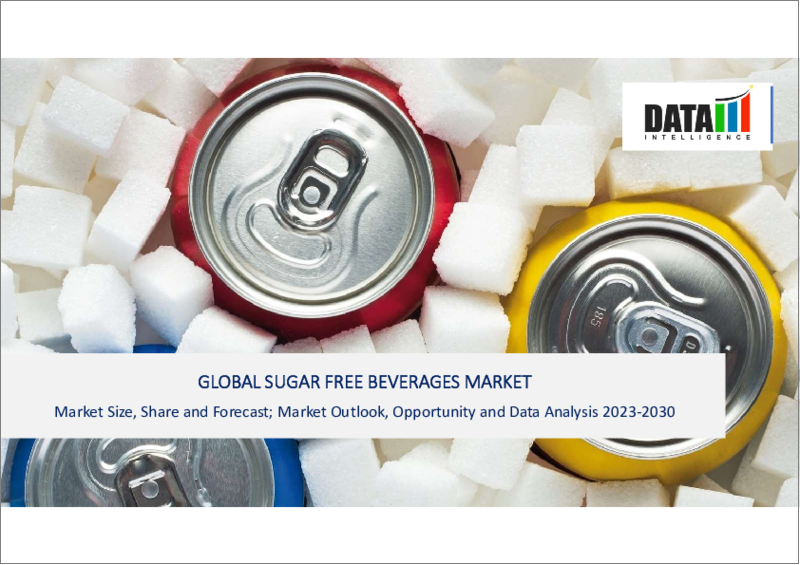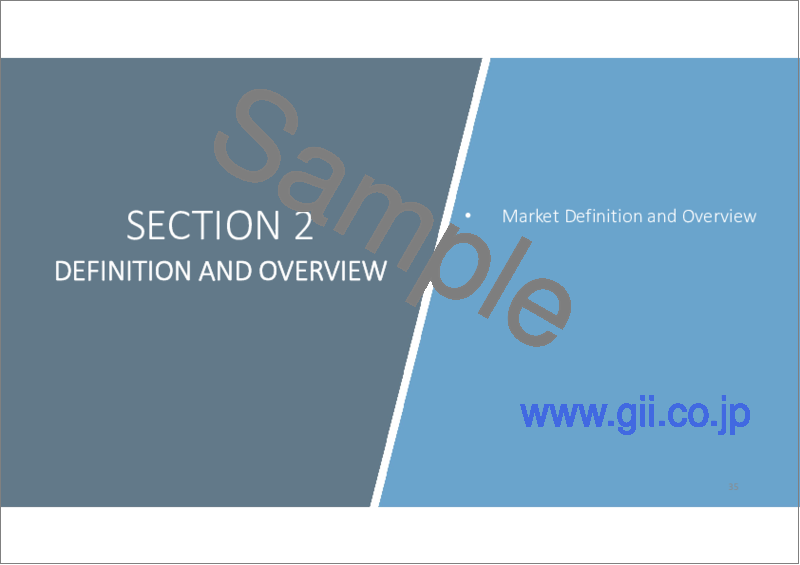|
|
市場調査レポート
商品コード
1304514
無糖飲料の世界市場-2023年~2030年Global Sugar Free Beverages Market - 2023-2030 |
||||||
|
● お客様のご希望に応じて、既存データの加工や未掲載情報(例:国別セグメント)の追加などの対応が可能です。 詳細はお問い合わせください。 |
|||||||
| 無糖飲料の世界市場-2023年~2030年 |
|
出版日: 2023年07月07日
発行: DataM Intelligence
ページ情報: 英文 190 Pages
納期: 約2営業日
|
- 全表示
- 概要
- 目次
市場概要
無糖飲料の世界市場は、2022年に79億米ドルに達し、2030年には109億米ドルに達すると予測され、予測期間2023-2030年のCAGRは4.2%で成長する見込みです。無糖飲料は高糖分飲料の代替品として人気を博しています。こうしたゼロカロリー・低糖質の選択肢は飲料業界で広く利用されています。多くの無糖飲料は、ステビア、スクラロース、アスパルテームなどの人工甘味料で甘味を付けており、カロリーを追加することなく満足のいく味を提供し、予測期間における無糖飲料市場の収益を牽引しています。
清涼飲料や炭酸飲料も、砂糖を含まないさまざまなオプションを提供することでこのトレンドを取り入れています。これらの無糖飲料は、爽やかで風味豊かな飲料を楽しみながら糖分の摂取量を減らしたい個人を対象としています。無糖飲料市場は、健康志向の高まりや体重管理を目的とする人々の増加など、いくつかの要因によって活性化しています。
世界的に人口のかなりの部分が肥満と闘っており、無糖飲料市場の需要は世界的に拡大しています。無糖飲料は、従来の砂糖の約600倍の甘さを持つ人工甘味料を利用することで、量を減らし、カロリーを抑えることができます。カロリー不足の食生活を採用し、体重管理を優先する人が増えるにつれて、無糖飲料市場の需要は増加の一途をたどっています。
市場力学
加糖飲料に関する懸念の高まりが市場を牽引無糖飲料市場の成長は、加糖飲料の健康への影響に関する懸念の高まりが牽引しています。砂糖の過剰摂取による悪影響に対する認識が高まるにつれ、より健康的な代替食品に対する需要が高まっています。例えば、2022年の世界保健機関(WHO)によると、成人のほぼ60%、子どもの3人に1人(男児の29%、女児の27%)が太りすぎや肥満とともに生活しています。砂糖無添加の飲料は、砂糖無添加または天然の代替品で作られており、砂糖の摂取量を減らしたい人に罪悪感のない選択肢を提供します。
炭酸飲料、フレーバー・ウォーター、エナジー・ドリンク、すぐに飲める紅茶など、幅広い選択肢があり、市場は満足感のある風味豊かな代替品を求める健康志向の消費者に対応しています。健康を優先し、砂糖不使用の選択肢を積極的に求める人が増えるにつれ、こうした飲料の市場は拡大を続け、健康に悪影響を及ぼすことなくのどの渇きを癒したい人々に、より健康的な選択肢を提供しています。例えば、2022年7月21日、中国で最も急成長している飲料ブランドである元気フォレストは、砂糖不使用のコーラ風味飲料を発売しました。
菜食主義と植物ベースの食生活の動向の高まりが無糖飲料市場を牽引する
無糖飲料市場は、菜食主義や植物ベースの食生活の動向の高まりによって牽引されています。このような食生活を選択する個人が増えるにつれて、彼らの価値観に沿った製品に対する需要が高まっています。2023年5月29日に発表された米国ビーガン協会の報告書によると、世界には約8,800万人のビーガンがいます。砂糖不使用の飲料は、菜食主義者や植物由来であることが多く、砂糖入り飲料の代替品を求める健康志向の消費者の間で人気が高まっています。
ステビアやモンクフルーツエキスのような天然甘味料を使ったこれらの飲料は、菜食主義者や植物ベースのライフスタイルを実践する人々の欲求に応える、罪悪感のない選択肢を提供します。肥満や糖尿病など、砂糖の過剰摂取に伴う健康リスクに対する意識の高まりが、より健康的な代替品への需要をさらに高めています。例えば、2022年7月28日、フルーツ風味の炭酸アルコール飲料会社であるWild Drum社は、低カロリー、ビーガン、グルテンフリーの炭酸飲料を発売しました。
砂糖代替品の高コストが市場成長を妨げます
無糖飲料市場の成長は、代替糖のコスト上昇によって阻害されています。より健康的な飲み物の選択肢を求める消費者の需要の増加に伴い、無糖飲料の人気は急上昇しています。しかし、こうした飲料の製造には、ステビア、スクラロース、アスパルテームといった高価な代用糖の利用が必要になることが多いです。これらの代用品の調達と調達に関連する費用は、全体的な製造コストの一因となり、無糖飲料は砂糖入り飲料に比べて価格が高くなります。この価格設定の不一致は、競争力のある価格設定を行い、コスト意識の高い消費者を惹きつける方法を決定しなければならないメーカーにとって課題となります。さらに、代替糖の高コストは利益率に影響を与え、無糖飲料生産の拡張性を妨げる可能性があります。
COVID-19影響分析
COVID-19分析には、COVID前シナリオ、COVIDシナリオ、COVID後シナリオに加え、価格力学(COVID前シナリオと比較したパンデミック中およびパンデミック後の価格変動を含む)、需給スペクトラム(取引制限、封鎖、およびその後の問題による需給の変化)、政府の取り組み(政府機関による市場、セクター、産業を活性化させる取り組み)、メーカーの戦略的取り組み(COVID問題を緩和するためにメーカーが行ったことをここで取り上げる)が含まれます。
人工知能分析
人工知能(AI)分析は、無糖飲料市場で重要な役割を果たしています。AIの力を活用することで、企業は消費者の嗜好、市場動向、製品開発の機会に関する貴重な洞察を得ることができます。AIアルゴリズムは膨大な量のデータを処理して消費者行動のパターンを特定し、正確な予測を行うことができるため、企業は無糖飲料の需要増に対応した製品を提供することができます。AIはまた、企業がサプライチェーンと在庫管理を最適化し、無糖飲料の効率的な生産と流通を確保することを可能にします。
目次
第1章 調査手法と調査範囲
第2章 市場の定義と概要
第3章 エグゼクティブサマリー
第4章 市場力学
- 市場への影響要因
- 促進要因
- 砂糖入り飲料に関する懸念の高まりが市場を牽引
- 抑制要因
- 砂糖代替品の高コストが市場成長の妨げとなっています。
- 機会
- 影響分析
- 促進要因
第5章 産業分析
- ポーターのファイブフォース分析
- サプライチェーン分析
- 価格分析
- 規制分析
第6章 COVID-19分析
第7章 タイプ別
- エナジードリンク
- RTD飲料
- 炭酸飲料
- フルーツ・野菜ジュース
- アルコール飲料
- その他
第8章 流通チャネル別
- スーパーマーケット/ハイパーマーケット
- オンライン販売
- コンビニエンスストア
- その他
第9章 地域別
- 北米
- 米国
- カナダ
- メキシコ
- 欧州
- ドイツ
- 英国
- フランス
- イタリア
- スペイン
- その他欧州
- 南米
- ブラジル
- アルゼンチン
- その他南米
- アジア太平洋
- 中国
- インド
- 日本
- オーストラリア
- その他アジア太平洋地域
- 中東・アフリカ
第10章 競合情勢
- 競合シナリオ
- 市況/シェア分析
- M&A分析
第11章 企業プロファイル
- The Coca-Cola Company
- 会社概要
- 製品ポートフォリオと説明
- 財務概要
- 主な発展
- PepsiCo, Inc.
- Monster Beverage Corporation
- Rockstar Inc.,
- Nestle Inc.
- Suntory Holdings Limited
- The Gatorade Company.
- The Kraft Heinz Company
- Pernod Ricard
- The Hershey Company
第12章 付録
Market Overview
The Global Sugar Free Beverages Market reached US$ 7.9 billion in 2022 and is expected to reach US$ 10.9 billion by 2030 and is expected to grow with a CAGR of 4.2% during the forecast period 2023-2030. Sugar-free drinks have gained popularity as alternatives to high-sugar beverages. These zero-calorie and low-sugar options are widely available in the beverage industry. Many sugar-free drinks are sweetened with artificial sweeteners like stevia, sucralose, and aspartame, providing a satisfying taste without the added calories and driving the sugar free beverages market revenue in the forecast period.
Soft drinks and carbonated beverages have also embraced the trend by offering a wide variety of sugar-free options. These sugar-free drinks cater to individuals looking to reduce their sugar intake while still enjoying refreshing and flavorful beverages. The sugar-free beverage market is fueled by several factors, including the increasing number of health-conscious individuals and those aiming to manage their weight.
With a significant portion of the population grappling with obesity worldwide, there is a growing demand for sugar free beverages market globally. Sugar-free beverages utilize artificial sweeteners that are approximately 600 times sweeter than traditional sugar, allowing for lower quantities and reduced calorie content. As more individuals adopt calorie-deficit diets and prioritize weight management, the market demand for sugar-free beverages continues to rise.
Market Dynamics
Rising Concerns Related to Sugar-Sweetened Beverages are Driving the Market The growth of the sugar-free beverages market is driven by rising concerns regarding the health effects of sugar-sweetened drinks. As individuals become more aware of the negative impacts of excessive sugar consumption, there is a heightened demand for healthier alternatives. For instance, According to World Health Organisation(WHO) in 2022, almost 60% of adults and one in three children (29% of boys and 27% of girls) are living with overweight or obesity. Sugar-free beverages, formulated without added sugars or with natural substitutes, provide a guilt-free option for those looking to reduce their sugar intake.
With a wide range of options available, including carbonated drinks, flavored waters, energy drinks, and ready-to-drink teas, the market caters to health-conscious consumers seeking satisfying and flavorful alternatives. As more people prioritize their well-being and actively seek out sugar-free options, the market for these beverages continues to expand, offering a healthier choice for those looking to quench their thirst without the negative health consequences. For instance, on July 21, 2022, Genki Forest is China's fastest growing beverage brand launched sugar-free cola-flavored drink.
The Growing Trend of Veganism and Plant-Based Diets Drives the Sugar Free Beverages Market
The sugar-free beverages market is being driven by the growing trend of veganism and plant-based diets. As more individuals embrace these dietary choices, there is a rising demand for products that align with their values. According to a American Vegan Society report published on May 29, 2023, there are approximately 88 million vegans in the world. Sugar-free beverages, often vegan and plant-based, are becoming increasingly popular among health-conscious consumers seeking alternatives to sugary drinks.
With natural sweeteners like stevia or monk fruit extract, these beverages offer guilt-free options that cater to the cravings of those following vegan or plant-based lifestyles. The rising awareness of the health risks associated with excessive sugar consumption, such as obesity and diabetes, further fuels the demand for healthier alternatives. For instance, on July 28, 2022, Wild Drum is a carbonated alcoholic beverage with fruit flavorings company launched a low-cal, vegan and gluten-free seltzer.
The High Cost of Sugar Substitutes Hindering the Market Growth.
The growth of the sugar-free beverage market is being impeded by the elevated cost of sugar substitutes. With increasing consumer demand for healthier drink options, the popularity of sugar-free beverages has soared. However, the production of these beverages often necessitates the utilization of costly sugar substitutes such as stevia, sucralose, and aspartame. The expenses associated with sourcing and procuring these substitutes contribute to the overall production costs, rendering sugar-free beverages pricier compared to their sugary counterparts. This pricing discrepancy presents a challenge for manufacturers who must determine how to competitively price their products and attract cost-conscious consumers. Moreover, the high cost of sugar substitutes can impact profit margins and hinder the scalability of sugar-free beverage production.
COVID-19 Impact Analysis
The COVID-19 Analysis includes Pre-COVID Scenario, COVID Scenario and Post-COVID Scenario along with Pricing Dynamics (Including pricing change during and post-pandemic comparing it with pre-COVID scenarios), Demand-Supply Spectrum (Shift in demand and supply owing to trading restrictions, lockdown, and subsequent issues), Government Initiatives (Initiatives to revive market, sector or Industry by Government Bodies) and Manufacturers Strategic Initiatives (What manufacturers did to mitigate the COVID issues will be covered here).
Artificial Intelligence Analysis
Artificial intelligence (AI) analysis is playing a significant role in the sugar-free beverages market. By harnessing the power of AI, companies can gain valuable insights into consumer preferences, market trends, and product development opportunities. AI algorithms can process vast amounts of data to identify patterns and make accurate predictions about consumer behavior, allowing businesses to tailor their offerings to meet the growing demand for sugar-free beverages. AI also enables companies to optimize their supply chain and inventory management, ensuring efficient production and distribution of sugar-free drinks.
Segment Analysis
The global sugar free beverages market is segmented based on type, distribution channel and region.
By Type, The Energy Drinks Segment is Estimated to Have a Significant Growth During the Forecast Period
The energy drinks segment accounted for the largest revenue share of around 46.86% in 2022.
Sugar-free energy drinks are beverages that offer a boost of energy without the added sugar found in traditional options. They are commonly used to increase alertness, improve physical performance, and enhance mental stimulation. With their caffeine content, these drinks can aid in focus, concentration, and cognitive performance, making them useful for studying or intense work.
Additionally, sugar-free energy drinks may elevate mood, motivation, and reduce fatigue. They can serve as a substitute for sugary beverages, helping to reduce calorie intake and manage weight. For instance, on May 27, 2022, Australian soft drinks company, Nexba, launched a range of caffeine- and sugar-free energy drinks with added vitamins and prebiotics
Geographical Analysis
North America is the Fastest Growing Market in the Sugar Free Beverages Market
North America region accounted for the largest revenue share of more than 51.3% in 2022. Sugar-free beverages have become increasingly popular in North America as people seek alternatives to traditional sugary drinks. These beverages offer a wide range of options for those looking to reduce their sugar intake or manage conditions like diabetes. Some common sugar-free options include diet sodas, flavored water, unsweetened tea, sparkling water, sugar-free energy drinks, and sugar-free sports drinks.
These beverages provide the taste and refreshment of their sugary counterparts without the added calories and sugar content. It's important to be aware of the ingredients, including artificial sweeteners, and to consume these beverages in moderation. Consulting with a healthcare professional can provide further guidance on choosing the right sugar-free beverages for specific dietary needs and health concerns. For instance, on January 9, 2023, Monster Energy launched energy zero sugar beverage in the North American region.
Competitive Landscape
The major global players in the market include: Coca-Cola Company, PepsiCo, Inc., Monster Beverage Corporation, Nestle Inc., Rockstar Inc., Suntory Holdings Limited, The Gatorade Company, The Kraft Heinz Company, The Hershey Company and Pernod Ricard.
Why Purchase the Report?
- To visualize the global sugar free beverages market segmentation based on type, distribution channel and region, as well as understand key commercial assets and players.
- Identify commercial opportunities in the market by analyzing trends and co-development.
- Excel data sheet with numerous data points of sugar free beverages market-level with all segments.
- The PDF report consists of cogently put-together market analysis after exhaustive qualitative interviews and in-depth market study.
- Product mapping is available as Excel consists of key products of all the major market players.
The global sugar free beverages market report would provide approximately 61 tables, 58 figures and 190 Pages.
Target Audience 2023
- Manufacturers/ Buyers
- Industry Investors/Investment Bankers
- Research Professionals
- Emerging Companies
Table of Contents
1. Methodology and Scope
- 1.1. Research Methodology
- 1.2. Research Objective and Scope of the Report
2. Market Definition and Overview
3. Executive Summary
- 3.1. Market Snippet, by Type
- 3.2. Market Snippet, by Distribution Channel
- 3.3. Market Snippet, by Region
4. Market Dynamics
- 4.1. Market Impacting Factors
- 4.1.1. Drivers
- 4.1.1.1. Rising concerns related to sugar-sweetened beverages are driving the market
- 4.1.2. Restraints
- 4.1.2.1. The high cost of sugar substitutes hindering the market growth
- 4.1.3. Opportunity
- 4.1.4. Impact Analysis
- 4.1.1. Drivers
5. Industry Analysis
- 5.1. Porter's Five Force Analysis
- 5.2. Supply Chain Analysis
- 5.3. Pricing Analysis
- 5.4. Regulatory Analysis
6. COVID-19 Analysis
- 6.1. Analysis of COVID-19 on the Market
- 6.1.1. Scenario Before COVID-19
- 6.1.2. Scenario During COVID-19
- 6.1.3. Scenario Post COVID-19
- 6.2. Pricing Dynamics Amid COVID-19
- 6.3. Demand-Supply Spectrum
- 6.4. Government Initiatives Related to the Market During Pandemic
- 6.5. Manufacturers Strategic Initiatives
- 6.6. Conclusion
7. By Type
- 7.1. Introduction
- 7.1.1. Market Size Analysis and Y-o-Y Growth Analysis (%), By Type
- 7.1.2. Market Attractiveness Index, By Type
- 7.2. Energy Drinks *
- 7.2.1. Introduction
- 7.2.2. Market Size Analysis and Y-o-Y Growth Analysis (%)
- 7.3. Ready-to-Go drinks
- 7.4. Carbonated Soft Drinks
- 7.5. Fruit and Vegetable Juices
- 7.6. Alcoholic Beverages
- 7.7. Others
8. By Distribution Channel
- 8.1. Introduction
- 8.1.1. Market Size Analysis and Y-o-Y Growth Analysis (%), By Distribution Channel
- 8.1.2. Market Attractiveness Index, By Distribution Channel
- 8.2. Supermarkets/Hypermarkets *
- 8.2.1. Introduction
- 8.2.2. Market Size Analysis and Y-o-Y Growth Analysis (%)
- 8.3. Online Sales
- 8.4. Convenience Stores
- 8.5. Others
9. By Region
- 9.1. Introduction
- 9.1.1. Market Size Analysis and Y-o-Y Growth Analysis (%), By Region
- 9.1.2. Market Attractiveness Index, By Region
- 9.2. North America*
- 9.2.1. Introduction
- 9.2.2. Key Region-Specific Dynamics
- 9.2.3. Market Size Analysis and Y-o-Y Growth Analysis (%), By Type
- 9.2.4. Market Size Analysis and Y-o-Y Growth Analysis (%), By Distribution Channel
- 9.2.5. Market Size Analysis and Y-o-Y Growth Analysis (%), By Country
- 9.2.5.1. The U.S.
- 9.2.5.2. Canada
- 9.2.5.3. Mexico
- 9.3. Europe
- 9.3.1. Introduction
- 9.3.2. Key Region-Specific Dynamics
- 9.3.3. Market Size Analysis and Y-o-Y Growth Analysis (%), By Type
- 9.3.4. Market Size Analysis and Y-o-Y Growth Analysis (%), By Distribution Channel
- 9.3.5. Market Size Analysis and Y-o-Y Growth Analysis (%), By Country
- 9.3.5.1. Germany
- 9.3.5.2. The U.K.
- 9.3.5.3. France
- 9.3.5.4. Italy
- 9.3.5.5. Spain
- 9.3.5.6. Rest of Europe
- 9.4. South America
- 9.4.1. Introduction
- 9.4.2. Key Region-Specific Dynamics
- 9.4.3. Market Size Analysis and Y-o-Y Growth Analysis (%), By Type
- 9.4.4. Market Size Analysis and Y-o-Y Growth Analysis (%), By Distribution Channel
- 9.4.5. Market Size Analysis and Y-o-Y Growth Analysis (%), By Country
- 9.4.5.1. Brazil
- 9.4.5.2. Argentina
- 9.4.5.3. Rest of South America
- 9.5. Asia-Pacific
- 9.5.1. Introduction
- 9.5.2. Key Region-Specific Dynamics
- 9.5.3. Market Size Analysis and Y-o-Y Growth Analysis (%), By Type
- 9.5.4. Market Size Analysis and Y-o-Y Growth Analysis (%), By Distribution Channel
- 9.5.5. Market Size Analysis and Y-o-Y Growth Analysis (%), By Country
- 9.5.5.1. China
- 9.5.5.2. India
- 9.5.5.3. Japan
- 9.5.5.4. Australia
- 9.5.5.5. Rest of Asia-Pacific
- 9.6. Middle East and Africa
- 9.6.1. Introduction
- 9.6.2. Key Region-Specific Dynamics
- 9.6.3. Market Size Analysis and Y-o-Y Growth Analysis (%), By Type
- 9.6.4. Market Size Analysis and Y-o-Y Growth Analysis (%), By Distribution Channel
- 9.6.5. Market Size Analysis and Y-o-Y Growth Analysis (%), By Distribution Channel
10. Competitive Landscape
- 10.1. Competitive Scenario
- 10.2. Market Positioning/Share Analysis
- 10.3. Mergers and Acquisitions Analysis
11. Company Profiles
- 11.1. The Coca-Cola Company
- 11.1.1. Company Overview
- 11.1.2. Product Portfolio and Description
- 11.1.3. Financial Overview
- 11.1.4. Key Developments
- 11.2. PepsiCo, Inc.
- 11.3. Monster Beverage Corporation
- 11.4. Rockstar Inc.,
- 11.5. Nestle Inc.
- 11.6. Suntory Holdings Limited
- 11.7. The Gatorade Company.
- 11.8. The Kraft Heinz Company
- 11.9. Pernod Ricard
- 11.10. The Hershey Company
LIST NOT EXHAUSTIVE
12. Appendix
- 12.1. About Us and Services
- 12.2. Contact Us




